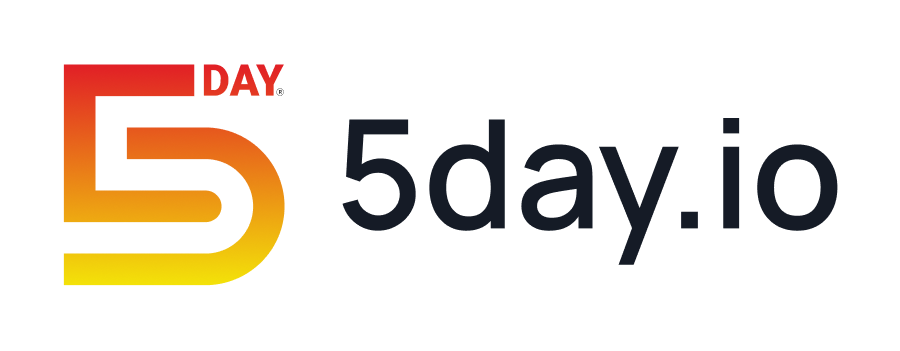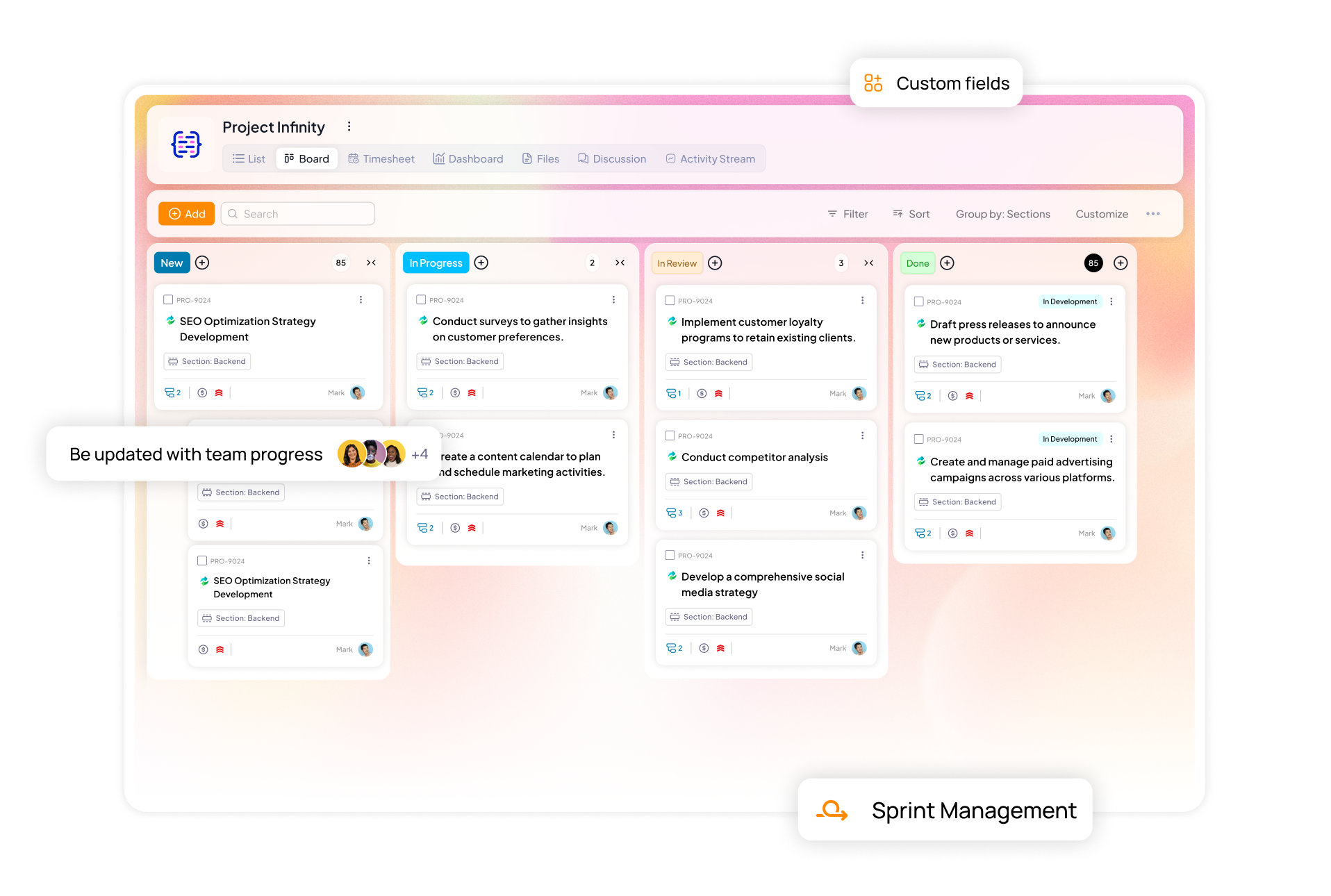You don’t lose time on a project all at once. You lose it in delays waiting for feedback. In missed context between emails and Slack threads.
What starts as a clear plan slowly turns into a scavenger hunt for updates. The initial confidence the client had in you starts chipping away. The client grows uneasy, and the work suffers, because the collaboration wasn’t built to hold the weight of real agency life.
Marketing team collaboration at an agency is about working smarter, with tools that make your flow part of how you work.
In this piece, we’ll unpack what real client collaboration should look like, and how the right platform can protect your people, your process, and the work you’re proud to ship.
Why effective client collaboration is everything for marketing agencies
You can have the most brilliant minds on your marketing team. But if you and your client aren’t deeply, rhythmically in sync, it can all fall apart.
Here’s what people don’t always say out loud. Marketing is not a function that keeps pushing out deliverables according to project scope to blindly meet targets. It’s deeply unifying. This happens when two sides, client and marketer, step out of their silos and build something together.
Not just through formal updates or clean feedback sheets, but through messy conversations, and shared wins that feel personal.
Real-time conversations keep the spirit alive
One day of waiting on feedback can turn into a week of lost momentum. Before you know it, the team that was once excited is now burnt out from starting and stopping.
That’s where real-time communication creates a smooth rhythm. When the client is looped in early, has reasonable bandwidth to respond before it’s too late, problems get caught sooner.
When people sync regularly, they feel belonged, and part of something bigger. Even if that means a few minutes of call over the course of a week. Being communicative also creates an atmosphere of safety, making clients feel their money is in safe hands, and that they have a rock-solid support system.
Alignment saves more than time, it saves relationships
The most painful revisions come from building something under one assumption, only to find out the client was imagining something completely different.
And that’s not on the team. It’s tempting to rush through discovery and jump into deliverables, especially when timelines are tight. But skipping alignment is like building a house without checking if the ground is level. Everything starts to wobble.
Trust is built in moments of honesty
Trust comes from doing the small, uncomfortable things in moments that matter. This can look like owning up when something doesn’t work or admitting you don’t know the answer, promising to go find it, and actually finding it.
When agency clients feel like they’re part of something genuine, someone who admits they are human and goes above and beyond to make things better, they start to relax.
They stop hovering.
They become collaborators, not critics. Because where there’s trust, there’s courage, and courageous marketing agency teams make bold, unforgettable work.
The best feedback loops feel like breathing, not like a chore
There’s feedback that moves the work forward, and then there’s feedback that just sends it in circles. The difference is real communication and understanding. When clients are brought into the thinking early, when they understand why choices were made, what constraints exist, what the data says, they give sharper, more useful input.
And in return, the team learns to hear the intention behind the notes.
The team feels like one unit
In marketing agencies, the most unforgettable projects are the ones where everything just worked, where ideas built on each other, and both the agency and client shared the same rhythm.
Read Also: How A Marketing Agency Increased Revenue Using 5day.io
When feedback is open, and progress feels natural, there’s no second-guessing, no chasing responses.
When teams move together like this, the results go beyond campaign performance. Even if the project doesn’t get a huge result, with an intuitive process, clients would love to come back and work on another project. This is only possible if you have an easy, super smooth collaboration system.
Common client collaboration blockers that plague marketing agencies
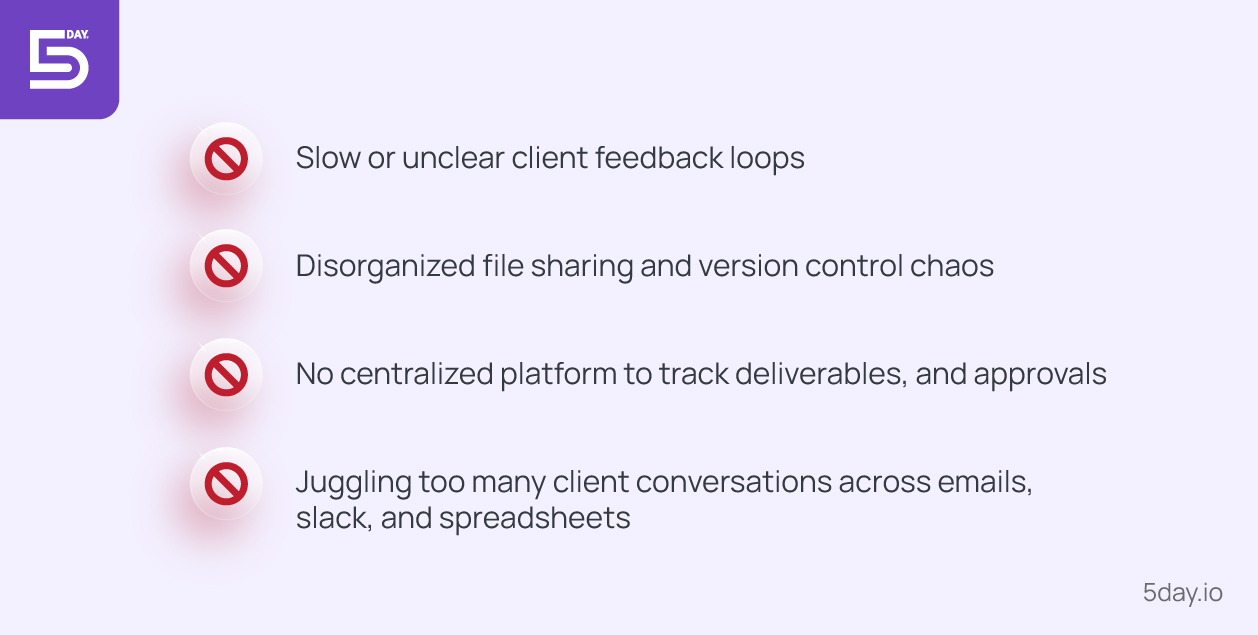
Recognizing and naming these patterns is the first step to fixing them.
-
Slow or unclear client feedback loops
Most marketing agency timelines assume timely feedback, but real life rarely plays along. Clients are busy. Decision-makers are hard to reach. And sometimes, the feedback that does come in is vague or contradictory: “Can we make it more exciting?” “It just doesn’t feel right.”
This puts agencies in a tough spot, trying to decode cryptic notes, or revising blindly without a clear direction. Everyone is frustrated at the end.
Read Also: How Poor Project Management Impacts Marketing ROI
This is one of the most persistent client collaboration challenges, and it’s worsened when there’s no structured feedback process in place. Feedback needs to be prompt, and actionable. Otherwise, the work spirals in circles.
-
Disorganized file sharing and version control chaos
Files like final_draft_v3_EDITED_approved_REVISED_finalfinal_V8.pdf keep cluttering your laptop daily.
They get scattered across Google Drive, Dropbox, email threads, and random Slack messages. No one knows which version is the latest. The client reviews the wrong file, and the team builds on outdated content. And by the time it’s caught, you’ve lost credibility.
For agencies handling multiple clients and campaigns, poor version control can be a massive blocker. It’s super risky.
One mistake in sending the wrong asset to a media partner or publishing outdated content can damage both the agency’s and the client’s reputation. A centralized file management system with version history, controlled access, and clear naming conventions fixes this and saves your time and trust.
-
No centralized platform to track deliverables, and approvals
When conversations happen everywhere all at once, things fall through the cracks. You keep wondering and moving in ambiguity, because you can’t ask the client to send the approved version, yet again. “Did the client sign off on this?” “Where’s the last version?” “What did they say on the call again?”.
This fragmented communication leads to duplicated work, and confusion about who owns what.
A lack of a centralized tool based in project management for client collaboration is one of the most common yet overlooked bottlenecks in the agency world. Clients get frustrated when they have to repeat themselves, and agencies get overwhelmed trying to juggle it all.
Read Also: How Does Project Management Simplify Content Creation?
The solution is simple.
One platform for briefs, timelines, conversations, feedback, and approvals. One place where everyone can stay aligned in real time.
-
Juggling too many client conversations across emails, slack, and spreadsheets
On any given day, an account manager may toggle between client emails, team Slack channels, WhatsApp updates, shared Google Sheets, and meeting notes from a Zoom call. Multiply that by multiple clients, and you get the picture.
People answer questions without the full context, and eventually, someone drops the ball, because there’s no place everyone is aligned, or track back conversations to. It becomes overwhelming, and at one point every account manager wishes they had a personal assistant to just tell them what they need and give it to them. That personal assistant is the project management software you use. Or it should be.
How marketing agencies can improve client collaboration tenfold using project management software
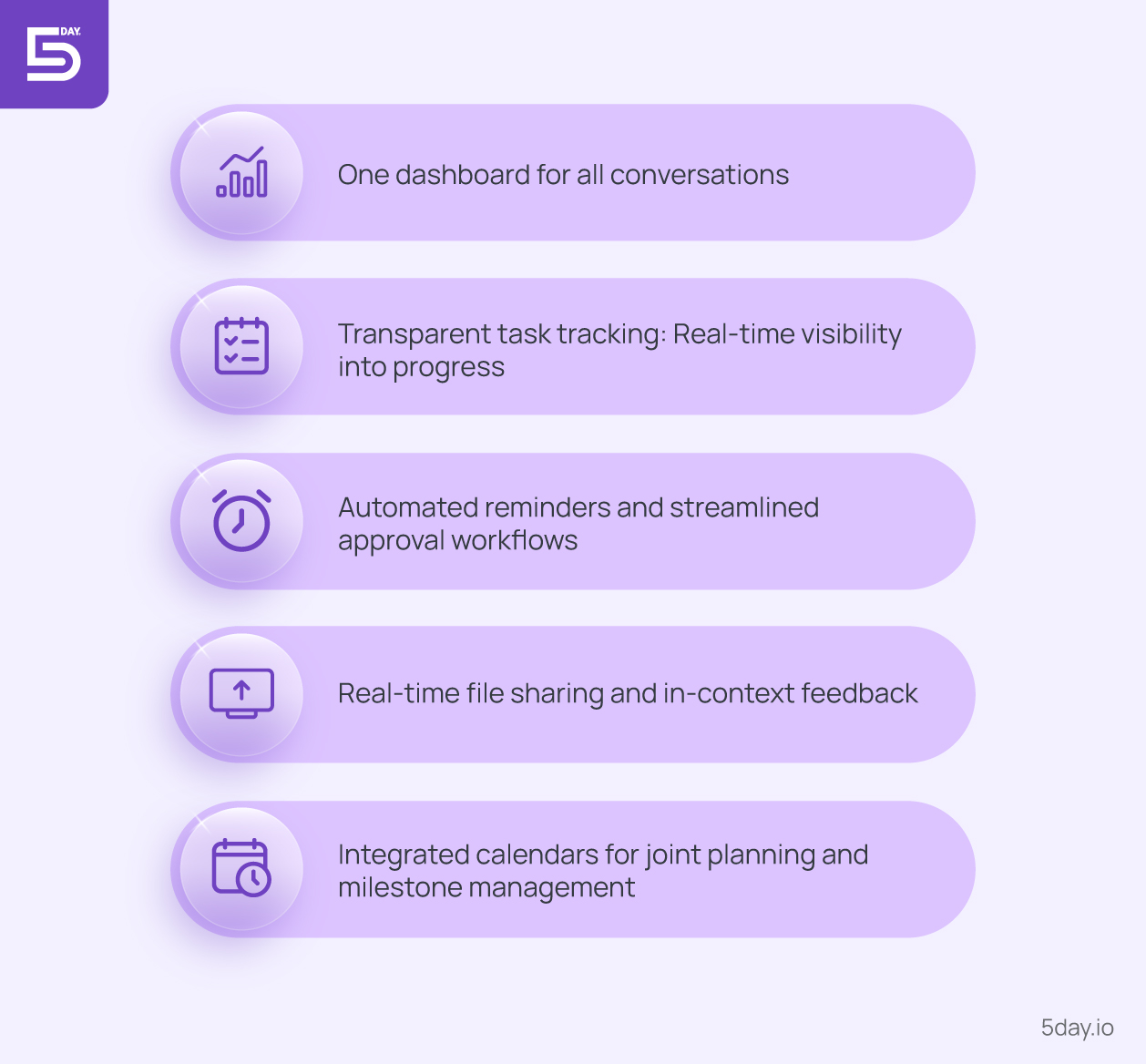
That said, the right project management software feels like your very own assistant who will have all the information you need and give it to you with the simplest search. Let’s expand this further.
One dashboard for all conversations
With the right tool, you can tag clients directly, loop in designers, and have threaded discussions around specific tasks or assets. No more trying to remember what was said in that late-night call.
Clients can log in anytime and see exactly what’s happening, and where to weigh in. This clarity reduces unnecessary check-ins.
Read Also: How to Solve Communication Silos in Marketing
Transparent task tracking: Real-time visibility into progress
Clients want to know what’s in progress, what’s blocked, and when they’re expected to take action. Without that, project managers’ role shifts and they are forced into the exhausting role of translator and status reporter.
With modern marketing team project management software, clients can track their particular projects and tasks and milestones in real time.
Whether through visual Kanban boards, Gantt charts, or timeline views, they gain immediate clarity on:
- What’s been completed
- What’s underway
- What’s behind schedule
- What needs their attention
This level of transparency keeps clients aligned with the agency’s workflow and reduces unnecessary meetings and update emails.
Automated reminders and streamlined approval workflows
Few things stall a campaign faster than delayed approvals. Everyone is busy, but no one takes a call, and the project doesn’t move ahead.
Project management tools eliminate this bottleneck through automated marketing workflows and reminders. You can assign reviewers, set clear approval deadlines, and trigger notifications the moment a task is ready for client review. Clients receive structured, timely reminders, without your team needing to manually nudge them.
Better yet, many tools allow multi-step approvals, so different departments or stakeholders can review sequentially or simultaneously.
Real-time file sharing and in-context feedback
No more searching for a file in an ocean.
A robust project management platform provides centralized, version-controlled file sharing. All creative assets, whether they’re PDFs, videos, wireframes, or documents are uploaded directly within the relevant task or project.
Stakeholders can view, comment, annotate, and approve files directly within the platform.
This ensures:
- Feedback is contextual and traceable
- The latest version is always clearly identified
- Creative revisions are faster and more accurate
For high-volume, multi-format campaigns, this alone can save hours each week and dramatically reduce the risk of publishing errors.
Integrated calendars for joint planning and milestone management
Marketing campaign plans depend on timelines, launch dates, content drops, media placements, and event schedules. Yet, planning often gets derailed when clients and teams work off separate calendars.
Project management platforms allow shared, integrated calendars where all key dates, internal and external, are visible to both agency and client. This creates a single timeline of truth, where delays are immediately visible and dependencies are clearly marked.
Clients see exactly how their approval delays impact launch schedules. Agencies can plan creative sprints and QA cycles with realistic buffers.
This level of calendar integration eliminates blind spots big time.
Read Also: 10 Warning Signs Your Agency Needs a Project Management Software
Key features agencies should look for in client collaboration tools
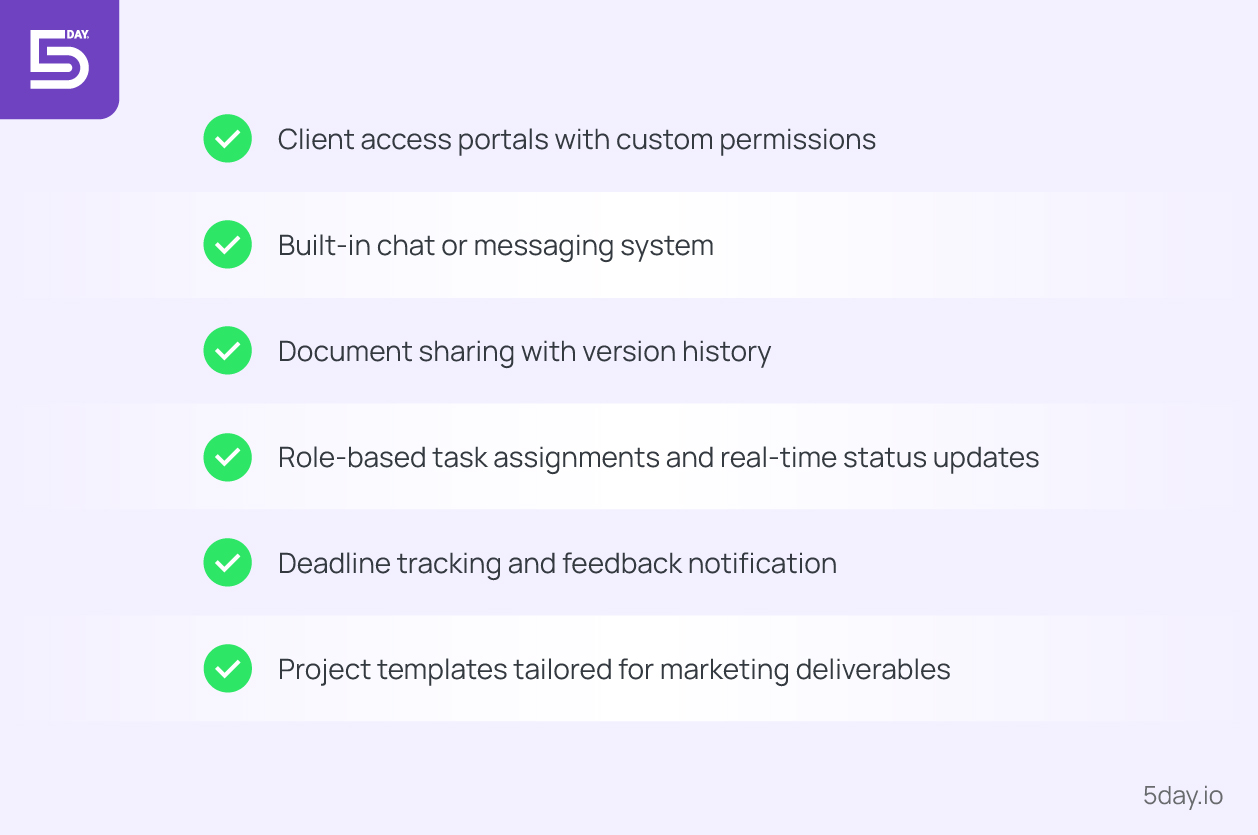
-
Client access portals with custom permissions
Your clients should be part of the process, without being overwhelmed by everything happening behind the scenes.
This is where dedicated client portals with granular permission controls come in.
A high-quality Team collaboration software should allow marketing agencies to:
- Give clients access to relevant projects, tasks, and files
- Restrict visibility to internal discussions or sensitive data
- Customize what clients can view, comment on, or edit
This prevents confusion while keeping clients engaged in the areas that matter, such as approvals, feedback, or deliverables.
More importantly, clients no longer need to email for status updates or ask where to find something. They simply log in and see what’s relevant to them.
-
Built-in chat or messaging system
While emails still have their place, they’re too slow for fast-moving campaigns.
A great collaboration software for marketing should include a real-time messaging system that enables swift, contextual communication.
Here’s why it matters:
- Quick questions can be resolved without meetings
- All conversations are attached to tasks or projects
- It reduces the need to toggle between third-party chat tools like Slack or Teams
For agencies, this means less context-switching and more focused communication. For clients, it means having a direct, searchable thread tied to the work, not buried in an email chain.
Bonus if the tool allows for threaded replies and mentions, with features that make chats more structured and action oriented.
-
Document sharing with version history
Content and creative development go through multiple revisions.
Without proper version control, it’s easy to lose track of the latest file, or accidentally publish the wrong asset. Your collaboration tool must include built-in document sharing with automatic version history.
This enables both agencies and clients to:
- Upload, preview, and comment on files directly in the platform
- Access previous versions with clear timestamps and changelogs
- Avoid duplicate efforts and incorrect feedback loops
This feature ensures everyone works on the most recent file, minimizes errors, and keeps the review process clean, and auditable, especially vital for campaigns.
-
Role-based task assignments and real-time status updates
One of the most powerful ways to streamline workflows is through role-based task management, where each team member and client stakeholder knows exactly what they’re responsible for.
Your chosen marketing collaboration software should allow you to:
- Assign tasks based on roles (creative, copy, client reviewer, strategist, etc.)
- Set priority levels and deadlines
- Track task progress in real time (e.g., “To Do,” “In Review,” “Approved”)
This removes ambiguity around ownership and keeps momentum high. It naturally drives accountability and reduces the need for constant status check-ins.
Clients also benefit by having visibility into where each deliverable stands, without needing to micromanage or send follow-up emails.
-
Deadline tracking and feedback notification
Whether it’s a campaign launch, ad scheduling, or content publishing, deadlines must be tracked meticulously, and everyone needs to be aware of what’s due, when, and who’s responsible.
A robust collaboration tool for marketing should provide:
- Visual calendars and Gantt charts for campaign planning
- Automatic deadline reminders to team members and clients
- Notification triggers for when feedback is requested, overdue, or completed
This makes the approval process far more efficient, especially when clients receive structured, timely alerts instead of ad-hoc pings.
-
Project templates tailored for marketing deliverables
Agencies often run similar types of projects, launch campaigns, content calendars, product launches, performance reporting cycles, and more. Starting from scratch every time is not only inefficient but introduces room for error.
That’s why great marketing collaboration software should offer customizable project templates built specifically for marketing workflows. These templates should include pre-built:
- Task lists (e.g., “Design Brief,” “Initial Concept,” “Client Review”)
- Approval stages and dependencies
- Asset upload structures and communication checkpoints
This standardizes execution across clients while giving your team a scalable way to maintain consistency, quality, and speed.
How 5day.io makes client collaboration seamless
5day.io was built specifically to solve the most pressing operational pain points faced by marketing agencies that blur accountability, and complicate delivery.
As one of the most intuitive marketing agency client collaboration tools available today, 5day.io bridges the gap between internal execution and client engagement with elegant simplicity.
5day.io is engineered from the ground up to deliver it, in real time, smoothly and at scale.
Dedicated client portals to save you hours of giving updates
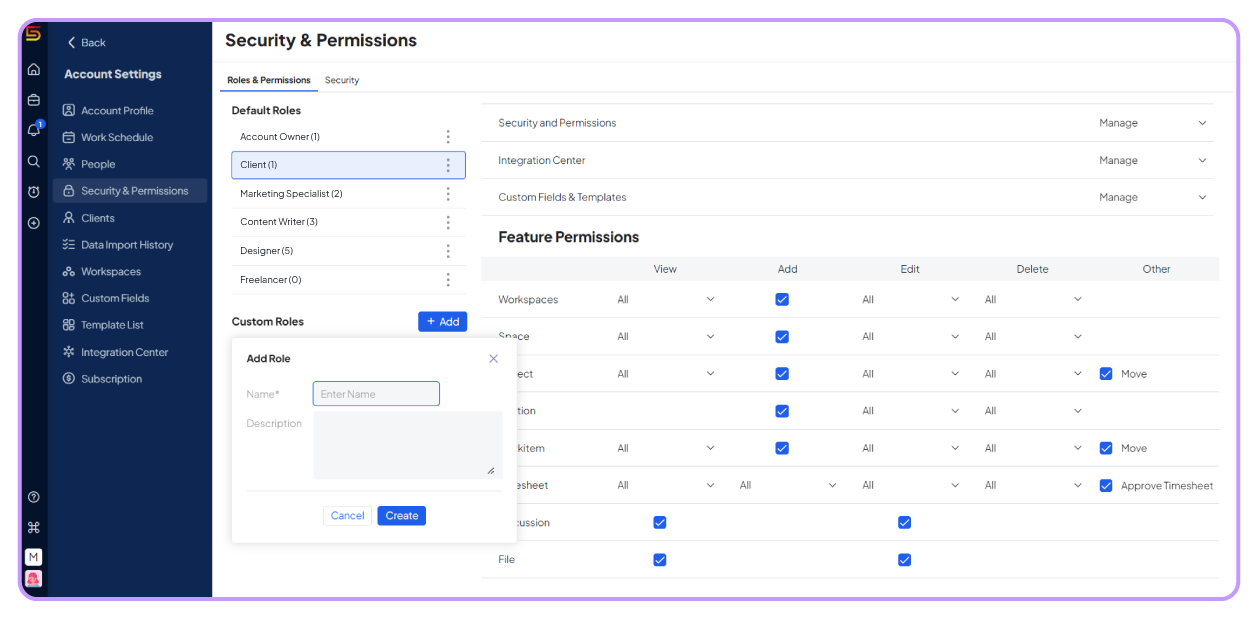
One of the most powerful features of 5day.io is its dedicated client portals with customizable access controls.
These portals are thoughtfully designed to give clients visibility into progress, and upcoming milestones, without flooding them with irrelevant details.
Agency teams can configure exactly what each client sees: task progress, specific deliverables, files, discussions, or timelines. This allows clients to check in, and comment asynchronously without interrupting the flow of work.
This careful permission setting strikes the perfect balance, with full transparency for the client, full control for the agency.
View progress any way you and the client want
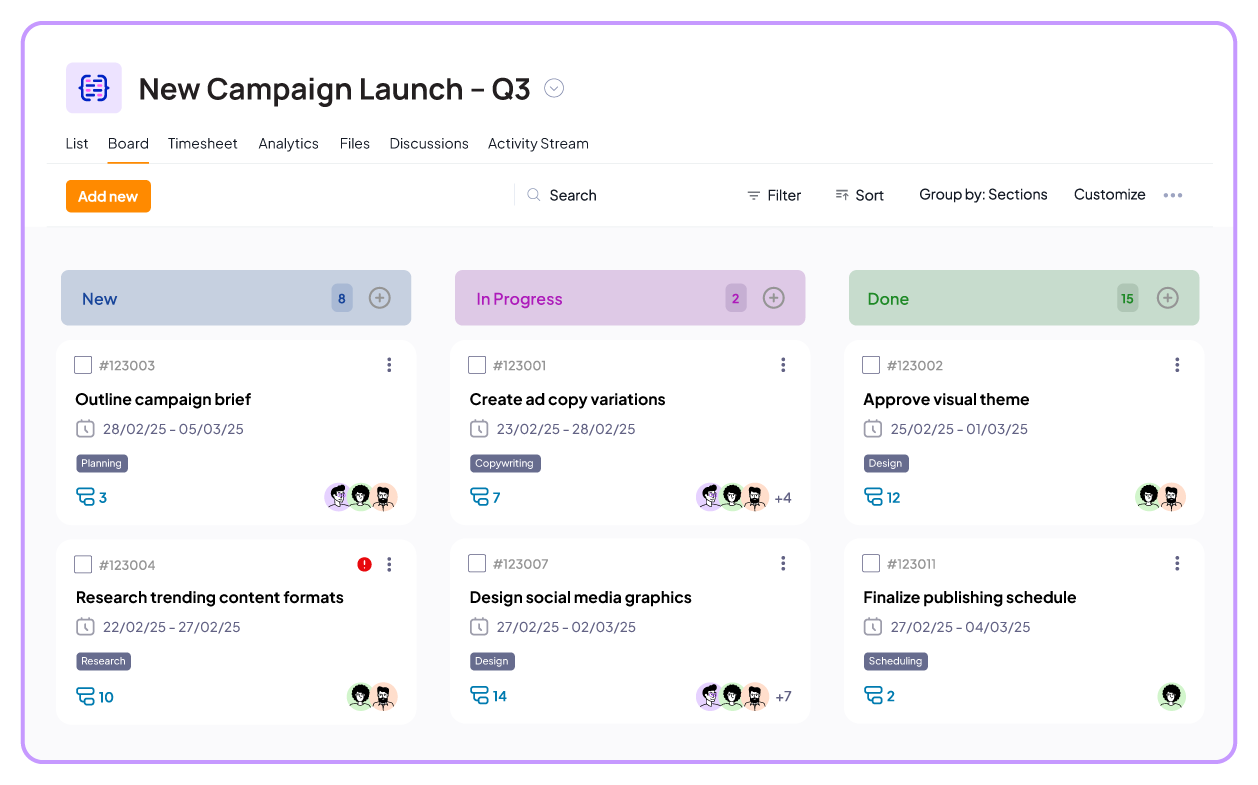
Where most tools force teams into rigid formats, 5day.io offers both Kanban boards and list views to match how different stakeholders think.
Creative teams might prefer the visual clarity of boards, dragging tasks between stages like “To Do,” “In Review,” and “Approved.” Meanwhile, clients and operations leads may need timeline-based insights into dependencies and deadlines, which Gantt views provide with drag-and-drop flexibility and auto-adjusting relationships.
Both views are synced and fully collaborative, meaning the moment a task is updated in one, it’s reflected in the other.
In-context feedback
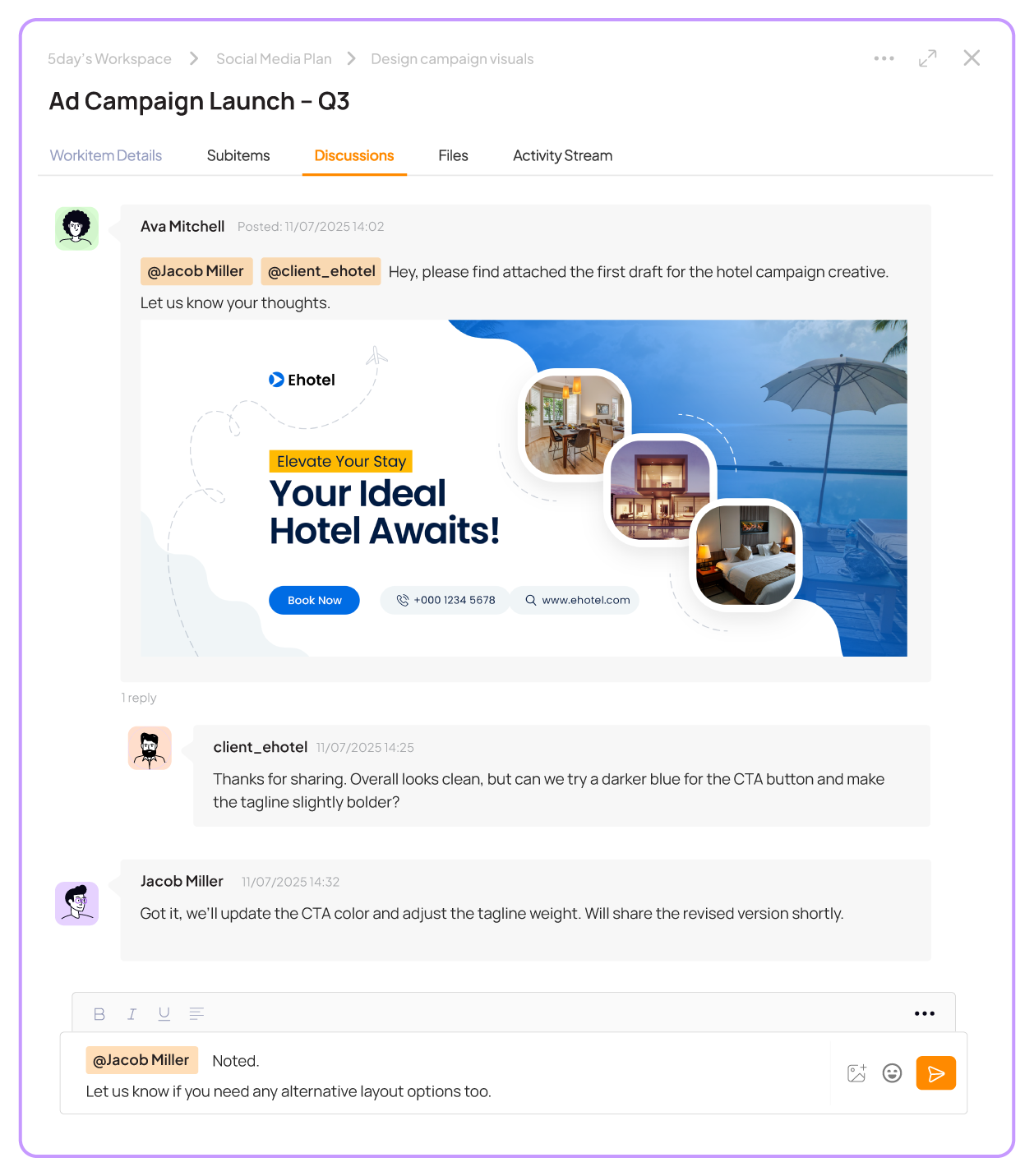
In terms of feedback, 5day.io eliminates the outdated loop of back-and-forth email chains and vague comments spread across chats, or PDFs. Its in-context feedback system lets clients comment directly within tasks and even on files, whether they’re images, videos, documents, or decks.
This feedback is centralized, timestamped, and visible to everyone involved, removing ambiguity and shortening revision cycles dramatically.
And because it integrates seamlessly with file version history, teams always know which version is being reviewed and what changes are required.
Deadline transparency
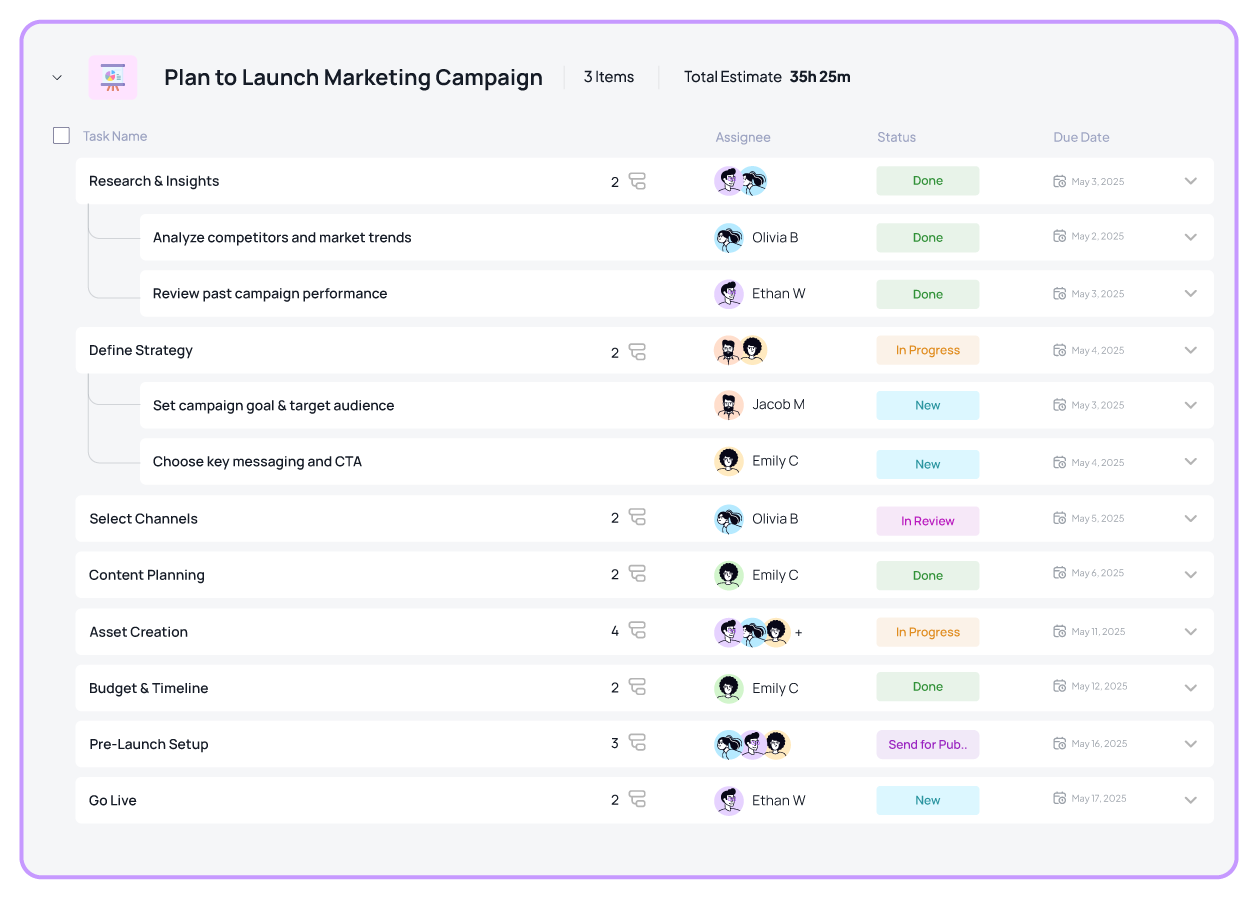
Another standout capability is 5day.io’s commitment to deadline transparency.
5day.io helps fix any delays by making all timelines, and dependencies clearly visible to both internal teams and clients. Clients are assigned responsibilities with due dates, and automated notifications ensure they’re reminded when action is required.
If a delay is unavoidable, its ripple effect across dependent tasks is automatically visible via the platform’s timeline views, enabling proactive planning instead of reactive damage control.
Want to see it in action? Sign up today and see how 5day.io can improve client collaboration for your agency.
FAQs
What is client collaboration in project management?
It’s how clients and teams work together throughout a project—sharing updates, giving feedback, and making decisions in real time.
What makes client coordination successful?
Clear roles, shared goals, open communication, structured feedback, and aligned deadlines.
Why is collaboration so important in marketing projects?
Because marketing moves fast. Campaigns need client input at every stage—collaboration keeps things on track and responsive.
What are the perks of using marketing collaboration software?
It keeps everything in one place—tasks, files, feedback—so projects move faster, smoother, and with fewer hiccups.
What should I look for in a marketing collaboration tool?
Look for tools with client portals, real-time updates, easy feedback, approval flows, and templates tailored to marketing.
How do I onboard clients to a new tool easily?
Keep it simple. Only show them what they need, walk them through it once, and highlight how it saves them time.
